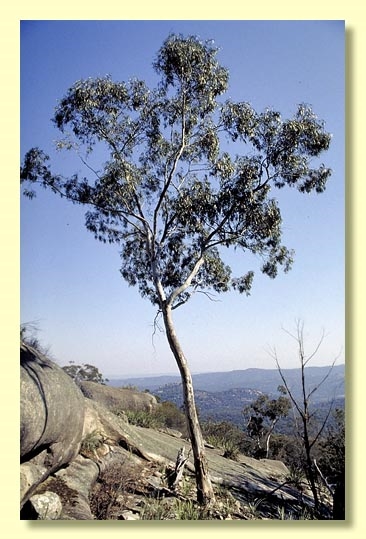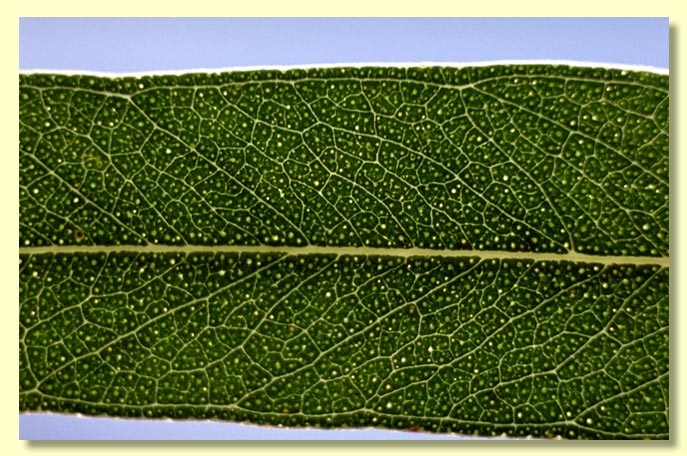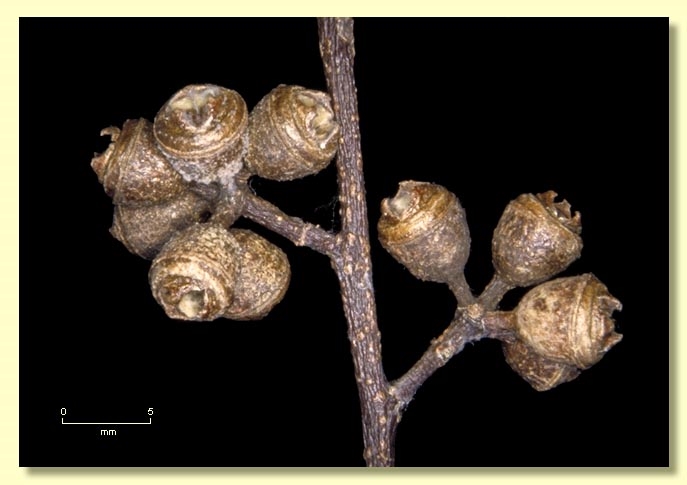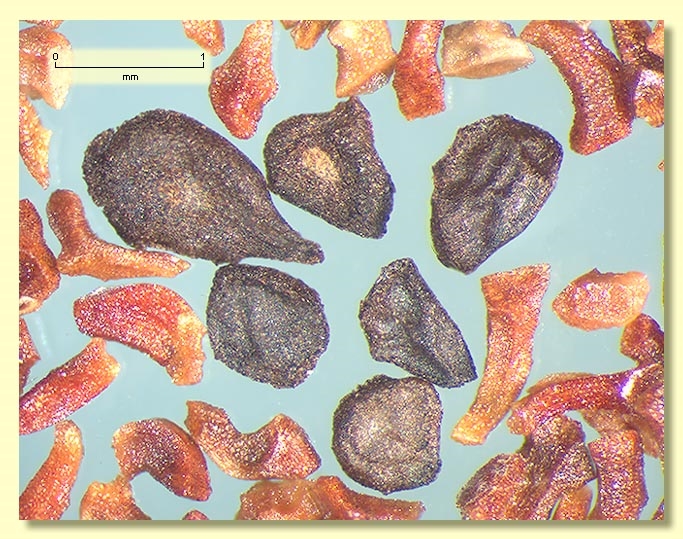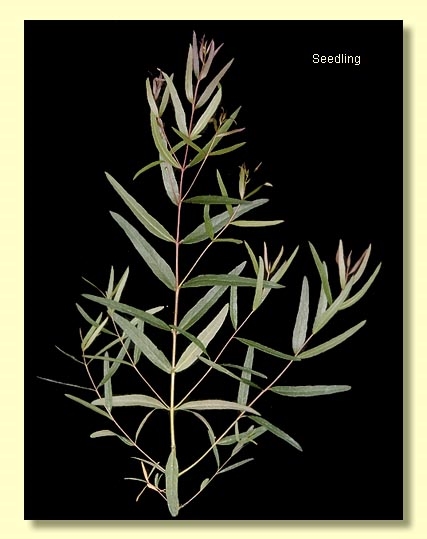Euclid - Online edition
Eucalyptus scoparia
Eucalyptus | Symphyomyrtus | Maidenaria | Triangulares | Microcarpae
T: near Wallangarra, Qld, July 1904, J.L.Boorman s.n.; holo: NSW322649, 322650.
Bark smooth, powdery, white and grey, shedding in strips.
Juvenile growth (coppice or field seedlings to 50 cm): stem usually round in cross-section; juvenile leaves opposite to sub-opposite for many nodes, sessile to shortly petiolate, linear to narrowly oblong, 4–8 cm long, 0.6–1.8 cm wide, base tapering to petiole, glossy, green.
Adult leaves alternate, petiole 0.5–1.7 cm long, linear to lanceolate to falcate, 6–16 cm long, 0.5–1.5 cm wide, base tapering to petiole, concolorous, glossy, green, side-veins at an acute or wider angle to midrib, moderately to densely reticulate, intramarginal vein parallel to and just within margin or remote from it, oil glands mostly island.
Inflorescence axillary unbranched, peduncles 0.5–1 cm long, buds 7 per umbel; pedicels 0.1–0.4 cm long. Mature buds pyriform or obovoid, 0.4–0.5 cm long, 0.3–0.4 cm wide, scar present, operculum conical to beaked, stamens irregularly flexed, anthers cuboid to oblong, versatile, dorsifixed, dehiscing by longitudinal slits (non-confluent), style long, stigma blunt, locules 3 or 4, the placentae each with 4 vertical ovule rows. Flowers white.
Fruit on pedicels 0.1–0.3 cm long, cup-shaped, hemispherical, or campanulate, 0.3–0.5 cm long, 0.4–0.6 cm wide, disc raised-convex to annular, valves 3 or 4, slightly exserted.
Seeds black or brown, 1.5–2 mm long, ovoid or flattened-ovoid, often pointed at one end, usually lacunose, dorsal surface shallowly pitted, hilum ventral.
Cultivated seedlings (measured at ca node 10): cotyledons oblong to bilobed; stems square to rounded in cross-section; leaves sessile to subsessile throughout, opposite to subopposite for many nodes (some alternate after ca 15 nodes), lanceolate to narrowly so, 4–8 cm long, 0.5–1.8 cm wide, base tapering, margin entire, apex pointed, concolorous, glossy, mid-green.
Flowring has been recorded in November.
Eucalyptus scoparia is frequently grown in south-eastern Australia as an ornamental tree in municipal and domestic gardens. It is a reliable and popular street and parkland tree in areas of moderate rainfall and very frosty winters.
Small to medium-sized tree confined to a few granite rocky mountains in the Great Dividing Range in the vicinity of Wallangarra (Castle Rock, Bald Rock, Mount Norman) near the border with New South Wales and Queensland and a bit further south in the Roberts Range area near Tenterfield. Eucalyptus scoparia is part of the E. mannifera group of species and has smooth white bark that is powdery in season, but differs from that species and other white gums in the area by having glossy green adult and juvenile leaves, and in the bark shedding in longer strips.
Eucalyptus scoparia belongs in Eucalyptus subgenus Symphyomyrtus section Maidenaria, a large group of species restricted to south-eastern Australia, characterised by bilobed cotyledons, simple axillary inflorescences, buds with two opercula, stamens with versatile anthers and flattened seeds with a ventral hilum. Within this section, E. scoparia and three other species (E. mannifera, E. dorrigoensis, E. elliptica ) form series Microcarpae diagnosed by the smooth white bark, juvenile leaves that are shortly petiolate, non-swampy habitat, and small, rather flat-topped fruit.
Eucalyptus scoparia is listed as "Vulnerable" under the Australian Government Environment Protection and Biodiversity Conservation Act 1999 (EPBC Act). Further information may be found at this web address:
http://www.environment.gov.au/cgi-bin/sprat/public/sprat.pl

